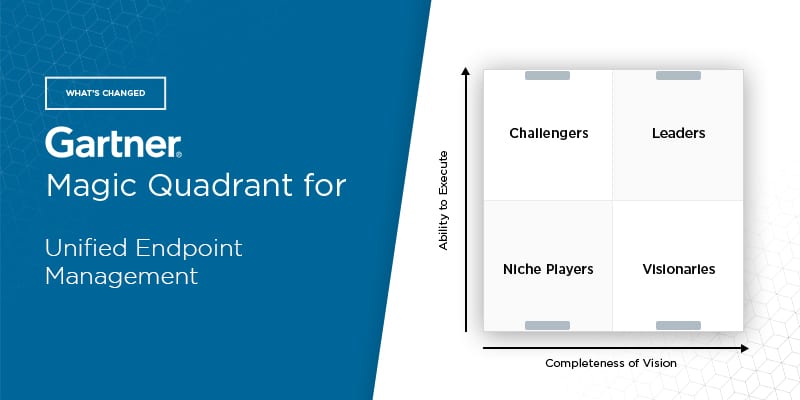What’s Changed: 2020 Gartner Magic Quadrant for Unified Endpoint Management

The editors at Solutions Review highlight what’s changed since the last iteration of the Gartner Magic Quadrant for Unified Endpoint Management and provide analysis of the new report.
Analyst house Gartner, Inc. recently released its 2020 Magic Quadrant for Unified Endpoint Management. This report looks at eight leading unified endpoint management providers: BlackBerry, Citrix, IBM, Ivanti, Microsoft, MobileIron, Sophos, and VMware.
Gartner defines “a set of offerings comprising mobile device management (MDM) and management of personal computers, via traditional client management tools (CMTs) or modern management, through a single console that also combines the application of data protection, device configuration and usage policies.” Gartner further defines modern UEM tools as providing a user-centric view of devices across device platforms; enabling PC management through native Windows 10, macOS and Chrome OS controls; enabling MDM through native iOS and Android controls; and aggregating analytics and telemetry from users, apps and devices to inform policy and related actions, among other capabilities.
In this Magic Quadrant, Gartner evaluates the strengths and weaknesses of eight providers that it considers most significant in the marketplace, and provides readers with a graph (the Magic Quadrant) plotting the vendors based on their ability to execute and their completeness of vision. The graph is divided into four quadrants: niche players, challengers, visionaries, and leaders. At Solutions Review, we read the report, available here, and pulled out the key takeaways.
Gartner named three Leaders to the Magic Quadrant report: Microsoft, VMware, and IBM. Microsoft’s UEM solution, Microsoft Endpoint Manager, combines Intune and Configuration Manager and is available with an Enterprise Mobility + Security (EMS) license. The company has been investing in improving end-user and IT admin experience, integrating UEM with endpoint security and identity solutions, and expanding analytics, AI and machine learning. VMware’s Workspace ONE product focuses on improved employee experience through UEM, virtualizations, analytics, applications, and workflows. The vendor is working to help employees implement zero trust solutions and improve employee experience with Workspace ONE Intelligence and Carbon Black endpoint security integrations. IBM Security MaaS360 with Watson focuses on AI-enhanced UEM, with investments in AI, new device alignment, and integration with security and identity products. The provider has a strong emphasis on midmarket clients and delivers intelligent insights through Watson AI.
The report’s sole Visionary, MobileIron, features extensive use cases and expanded macOS support and its zero sign-on provides secure UEM access. While MobileIron Core isn’t as versatile as its cloud offerings, the vendor is increasing the value of its endpoint security, macOS, and frontline worker capabilities. In addition, Gartner listed BlackBerry and Ivanti as Challengers; BlackBerry features a highly secure UEM solution that also offers a complete unified endpoint security solution, even if its PC management and platform strategy is limited. Ivanti Unified Endpoint Manager continues to expand its client management capabilities as the vendor transitions into single-pane endpoint management.
Rounding out the report are Citrix and Sophos, the two Niche Players of this year’s Magic Quadrant. Citrix typically offers its Citrix Endpoint Management (CEM) product as as part of a management suite rather than as a standalone UEM software. However, it offers geographically diverse operations and a commitment to analytics, zero trust, and improving frontline support and third-part security integration. Sophos also offers a unified endpoint security solution on top of its UEM system, and has grown its customer base to go beyond its midmarket focus. However, the vendor still suffers from a lack of endpoint diversity and brand awareness within the device management field.
Read the Gartner 2020 Magic Quadrant for Unified Endpoint Management.
Looking for more info on the benefits of mobility management? You should check out our free Mobility Management Buyer’s Guide. We profile the top vendors in the mobility management field, list their key capabilities, and determine our Bottom Line for each.
Check us out on Twitter for the latest in Enterprise Mobility news and developments!




















